Skiing in Vail
The front side of Vail Mountain offers a trails for every ability level, but Vail’s seven legendary Back Bowls are what set Vail apart from the rest.
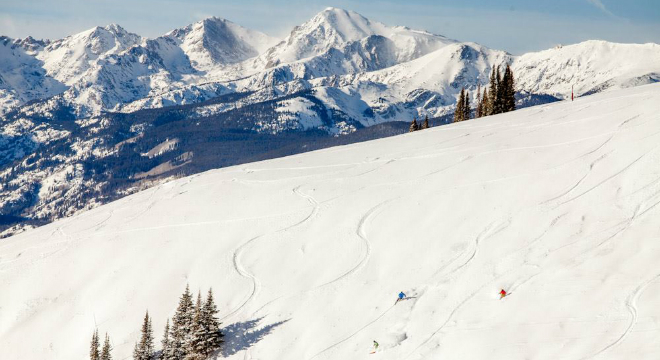
The Legendary Back Bowls (Photo Credit: Vail Resorts)
Vail Ski Area Overview
The ski and snowboard experience at Vail is enveloping, and keeps ahead of its rivals by investment in facilities-lifts, runs, ski school, and instruction. There are plenty of runs, generally short lines and in the unlikely event you should tire of the Vail’s slopes, there are a half dozen others nearby resorts. Base elevation is 8,120 feet (2,475 m) while the summit reaches 11,570 feet (3,527 m), giving a vertical descent of 3,450 feet (1,052 m).
Vail is so big it is difficult to comprehend unless one has been there. This poses quite a challenge for Vail’s PR department. It is simply impossible to put into words the massive size of the resort. It is the biggest in North America in terms of acreage and dwarfs its competitors. For example, Vail is so large that all four Aspen resorts (Aspen Mountain/Ajax, Buttermilk, Aspen Highlands, and Snowmass) would fit nearly within Vail’s boundaries. Vail is so big, it doesn’t have just one slopeside base village – it has three: Vail Village, the newly redesigned and European-esque Lionshead Village, and Golden Peak Village.
With 193 trails and 5,289 acres (2,140 ha) of skiing, Vail has a lot to offer. While some mountains have a little bit of everything, Vail has a lot of everything. Vail is comprised of three separate and distinct sections: the Front Side, the Back Bowls and Blue Sky Basin. The front side of Vail Mountain-mostly north facing-offers a conventional trail design cut through the trees, featuring terrain for every ability level. Vail’s seven legendary Back Bowls offer 2,724 acres (1,102 ha) of wide-open expansive terrain that is a must-ski on a powder day. Blue Sky Basin, the north-facing front side of the next ridge beyond the Back Bowls, offers Vail’s best expert terrain.
Ski trails are graded green for beginner, blue for intermediate, black for advanced/expert, and double black for experts only. With 18 percent beginner, 29 percent intermediate and 53 percent advanced/expert, the emphasis is less on cozy, more on challenging. Having said that, Vail is good for beginners and in comparison to some other resorts-especially the more challenging European resorts-there is a tendency to over-classify some black runs.
Snow reliability on north-facing slopes is excellent with an exceptional natural snow record supplemented by extensive snowmaking facilities. Snow quality is not always so good in the Back Bowls as these are mostly south-facing slopes, except Blue Sky Basin-largely north-facing and sheltered from the sun by trees-which holds good powder for several days after the last snowfall.
Vail has been recognized as having an exemplary skier-safety program for both education and enforcement. The program includes a stand-alone safety group tasked with monitoring, education, enforcing, and providing positive reinforcement of “Your Responsibility Code”. Skiers and snowboarders are taught about Your Responsibility Code through increased signage on the mountain, in on-mountain restaurants, and elsewhere. Some visitors may occasionally find the yellow-jacketed mountain safety officers a little overzealous, though.
Blue Sky Basin, the jewel in Vail’s terrain crown, is a must for intermediate to advanced skiers and boarders. It provides a genuine backcountry ski experience and is different from any other area on Vail Mountain. Blue Sky Basin features 645 acres (261 ha) of intermediate to advanced terrain in Pete and Earl’s Bowls. There are some easy groomed (blue) trails but most of the terrain is ungroomed, and because it is mostly not very steep it allows intermediates the opportunity to experience the thrill of exploration and adventure as they find their own way on in-bounds ungroomed terrain. It also provides a means of escaping the crowds on other parts of the mountain.
Beginner Skiing at Vail
Vail’s Beginner Skiing is as expansive as the resort itself. With lots of green runs to choose from all across the mountain, novice skiers love Vail.
At Vail, beginners get to start at the top-at the top of the mountain that is. The beginner area is located at the top of the Eagle Bahn Gondola at Eagle’s Nest. Nursery slopes at altitude and lower down at resort level are excellent but they can be overcrowded. While Vail’s legendary Back Bowls and Blue Sky Basin are meant for more experienced skiers, beginners can ski in places all over the front side of Vail Mountain from Golden Peak to Lionshead.
Intermediate Skiing at Vail
In Vail, intermediates can ski much of the same terrain as advanced skiers, even the Back Bowls and Blue Sky Basin, providing they choose the easier trails and gradients.
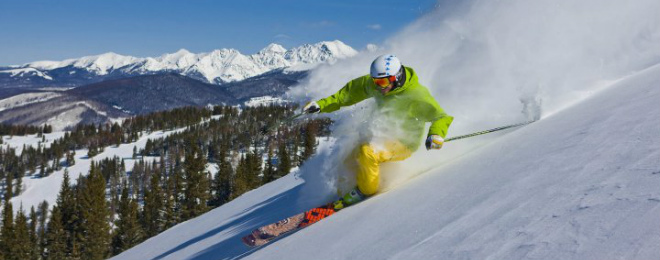
Photo Credit: Vail Resorts
The bulk of the Vail’s front face is intermediate level with plenty of easy cruising trails-and that means it is well suited to most skiers. Intermediates wanting something more challenging can check out the easier black diamond trails on the front face, before moving on to the Back Bowls. There you can find easy, groomed blue trails as well as ungroomed slopes which-snow conditions permitting-offer good opportunities to learn to ski powder.
In Vail, intermediates can ski much of the same terrain as advanced skiers. It’s a matter of choosing different trails in the same areas, like the Back Bowls and Blue Sky Basin, and selecting trails with gradients that suit your ability and confidence level. There are a handful of intermediate trail pods, but intermediates can ski off almost every chair. The longest trail, Riva, is four miles (6.4 km) long and is also the most challenging for a number of reasons: it has an interesting fall line in places and tends to have steeper sections as well as bumps.
Many intermediates enjoy the Game Creek Bowl at the far right of the Front Side, but beware. Once you’re at the bottom of Game Creek Bowl, the only way out if the often-crowded Game Creek Express Quad.
Get to know the more than 5,200 acres (2,106 ha) of skiing with a free “Meet the Mountain” tour, starting at 9:15 am from the Eagle Bahn Gondola. A guide takes intermediate skiers and snowboarders to the best spots on the mountain. Stop for lunch at the best restaurant on the mountain, Two Elk. Featuring gourmet pizza, pasta and wraps, Two Elk provides one of the best views of the Gore Range. In the afternoon, ski the legendary Back Bowls until 3:00 pm then finish the day on the front of the mountain and ski Pepsi’s face, the old World Cup downhill course, into Vail Village.
Advanced & Expert Skiing at Vail
Vail’s expert terrain is all about powder in the Back Bowls and great frontside runs.
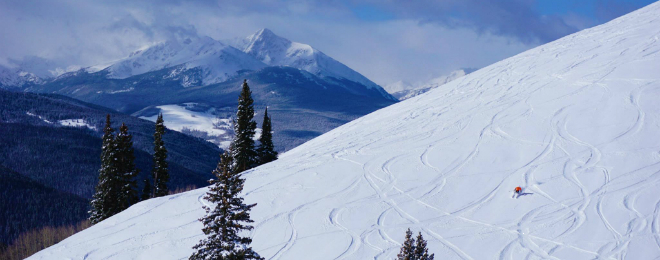
The Back Bowls (photo credit: Vail Resorts)
Vail is famous for its expansive terrain. With three different sides to explore it’s difficult to get bored at Vail. Expert terrain is spread across three distinct faces: the Front Side, the Back Bowls and Blue Sky Basin. The Front Side is home to traditional treelined ski runs and some of the more challenging runs on the hill can be found off the Highline and Northwoods Express Quads. Over the backside of the mountain are the legendary Back Bowls and beyond them lies Blue Sky Basin, home to Vail’s most challenging off piste terrain.
True experts will find the number of black diamond trails to be plentiful, but the steepness of those trails to be somewhat weak. In some respects, that’s part of the Vail experience. The ski resort has built a loyal following amongst vacationing skiers who come out especially to ski – and later brag about – the Back Bowls. At most other Western resorts (e.g. Aspen or even sister resort Breckenridge), much of Vail’s black diamond terrain would be classified as blue. True expert skiers looking for spine-tingling steeps, couloirs and cliff should look elsewhere. For the vast majority of skiers though, the Back Bowls are worth the pilgrimage and even the most ardent expert would be forced to admit there’s something very enjoyable about skiing down huge, open powder bowls. And no one has as many as Vail.
Front Side Expert Skiing
Many first time visitors to Vail make the mistake of skipping the front side entirely, so powerful is the allure of the Back Bowls. They miss out on some of the best expert skiing on the mountain and shorter lift lines. The Front Side offers a variety of terrain that the homogenously open Back Bowls do not. In fact, there are black diamond runs from almost every Front Side lift.
Working from left to right on the trail map, we start our examination of the Front Side steeps at the Highline Express Lift. Because this pod of terrain is so far to the extreme boundary of the resort, it is easily overlooked. This area is home to the best mogul skiing on the mountain. In particular, Highline is worth a run for anyone who likes to bash moguls, but Roger’s Run is the most challenging of the bump runs because of its double fall line.
Just a short traverse away is the Northwoods Express. If heading back to the chair, a handful of short blacks at the top of the chair – the most interesting of which is Gandy Dancer – give way to long run outs. But a quick traverse down the green Swingsville trail leads to another trio of first class expert runs. Prima Cornice is, in our opinion, the most challenging trail at Vail and is should top the list of Front Side must-ski runs. The Prima (trail) to Pronto combination is also worth at least one lap.
Continuing farther towards the center of the trail map, skiers come across the most famous Front Side run – Riva Ridge. Vail was founded by veterans of the US 10th Mountain Division and Riva Ridge was a bloody battle fought in the Italian Alps. The trail is famous not so much for a section about 2/3 of the way to the bottom known as “Tourist Trap,” so named because the upper sections of the trail can lull intermediates into a false sense of security before the bottom drops out on this steeper (usually icy and scraped) section. Vail’s ever-present yellow-jacketed mountain ambassadors are waiting at the bottom to give warnings and pull tickets from beginners who got in over their heads despite the multiple warning signs above. When skiing down Riva Ridge, look up to the left to see the exits from a quartet of short double black diamond tree runs, all of which are accessible from the top of the Eagle Bahn gondola.
The Game Creek Bowl (the only Front Side bowl) and the adjacent Wildwoods Express Chair offer a nice collection of shorter, groomed black runs that are popular with progressing intermediates. The remainder of the Front Side is scattered with black diamonds, but those omitted from this primer are generally shorter and less interesting.
Back Bowls Expert Skiing
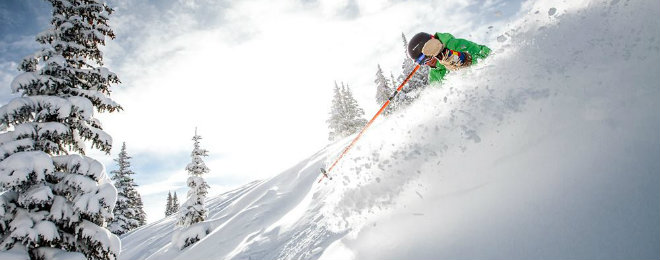
Powder Day in the Back Bowls (photo credit: Vail Resorts)
The Back Bowls transcend skiing. Even non-skiers have heard about the legendary Back Bowls and Vail went so far as to trademark the term. So what’s all the hype about?
The Back Bowls are actually one, long continuous ridgeline. This southern-facing slope was the victim of a wildfire shortly before the ski resort was founded, leaving this exposure almost entirely devoid of trees. In size and scale they are unparalleled in North America. It can easily take several hours to work from one end to the other and it’s difficult to describe the vast, emptiness of the bowls to anyone who is unfamiliar with skiing in Europe where such treeless expanses are more common. They are truly unique and awe-inspiring.
In general, the Back Bowls are rated as single black diamonds, with a few steeper double black and less steep blue pitches demarked on the map. In truth, strong intermediates comfortable skiing on ungroomed snow will have little difficulty skiing the Back Bowls except when conditions are made more challenging by a lack of recent snow. During these less snowy stretches, the bowls’ southern exposure can result in freeze-thaw conditions that make skiing them a lot of work even for strong expert skiers.
Technically, there are five Back Bowls, from left to right on the trail map: Sun Down Bowl, Sun Up Bowl, Teacup Bowl, China Bowl and Siberia Bowl. With the exception of the cirque-shaped Sun Down Bowl, it can be difficult to tell exactly where one bowl ends and another begins. The many trails marked on the trail map are indicate various lines down the bowls, but they too are intermingled and sometimes indistinguishable.
Again owing to a position on the periphery of the resort, Sun Down Bowl tends to receive the least attention from visitors, though the honor of least crowded bowl falls to Siberia Bowl on the opposite boundary. The trails here are actually amongst the more interesting in the Back Bowls because they are treed. Many visitors want the true “Back Bowl” experience and so also eschew these runs because they are less open.
Adjoining Sun Up Bowl can be skied in whole or in part. The runs here tend to be more open than Sun Down Bowl and are quite popular because they are perhaps the easiest to reach from the Front Side. The Sun Up Lift halfway down the Sun Up Bowl provides both an escape for intermediates in over their heads as well as a convenient means of transport to the top of Teacup Bowl.
Teacup Bowl is the smallest of the five Back Bowls and easily missed as skiers move from Sun Up Bowl to China Bowl. Teacup Bowl occupies a tiny hollow between the two and offers a handful of open runs that funnel back to the Teacup Express. Be warned, however, that the Teacup Express is the only lift back to the Front Side from Blue Sky Basin. When Blue Sky Basin closes at 2:30, liftlines at the Teacup Express can stretch over an hour on busy days.
Next to Teacup bowl is China Bowl, the gentlest of the Back Bowls the only one to offer blue trails that run down the fall-line of the bowl. Often, Vail will groom wide swaths of China Bowl using 10 or more groomers, creating a European-style piste through the middle of the otherwise off-piste terrain. China Bowl has the fewest trees of any of the Back Bowls and is perhaps the part of Vail that most embodies the vision of what first timers imagine the Back Bowls to look like. A handful of small cliffs sprinkled in on the skier’s right side of the bowl (giving rise to the name for the black Dragon’s Teeth run) are the closest expert skiers will get to anything intense on this side of the mountain. Nearby Ghengis Khan is considered the steepest pitch in the Back Bowls.
Lastly, on the far right of the trail map is Siberia Bowl. Siberia Bowl is both the largest and least skied bowl at Vail. It is also, in our opinion, the best of the Back Bowls. In large part the sparseness of crowds is attributable to the fact that Siberia Bowl is not serviced by its own lift. The entrance is hidden off to the side of China Bowl and requires skiers to take the Mongolia poma lift to reach its summit. From there, a number of large bowls with short, widely-space pine trees await. Powder tends to stay here longer because fewer skiers find Siberia Bowl. Even those that do are often turned off by the flat traverse at the bottom back to the Orient Express chair. If there can be said to be a secret in the Back Bowls, it is unquestionably Siberia Bowl. It’s worth the circuitous poma entrance and flattish traverse out.
Blue Sky Basin Expert Skiing
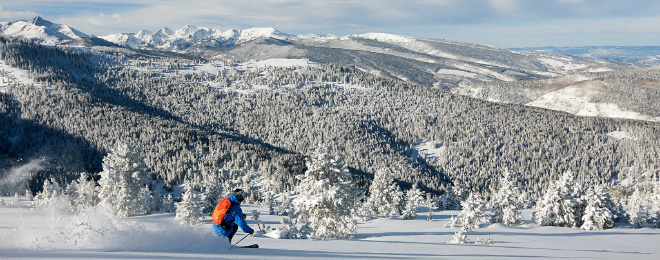
Champagne Glade at Blue Sky Basin (photo credit: Vail Resorts)
Blue Sky Basin is the newest of Vail’s three faces. When it opened in 2000, it set off a terrain expansion arms race across the Rockies. Suddenly, Vail had true off-piste skiing that could attract expert skiers. The opening of Blue Sky Basin heralded a new era in the sport where resorts started to bring theretofore backcountry skiing within their boundaries because skiers, equipped with new fatter skiers, demanded more powder and more challenging slopes.
While revolutionary when it opened in 2000, Blue Sky Basin has been eclipsed by many other Rockies resorts. The terrain is easily the most interesting and challenging of Vail’s off-piste offerings, but, again, true expert skiers won’t be overly impressed. Aspen, Telluride, Big Sky and any number of other Rockies resorts have far scarier steeps. The main difference between the Back Bowls and Blue Sky Basin is trees, not pitch.
Blue Sky Basis is actually two separate peaks serviced by three express quads. The more popular and easily accessible of the two peaks is on the right of the trail map and is serviced by the Skyline Express Lift. Skiers can easily reach this lift by skiing past the bottom of the Teacup Express Lift at the base of Teacup Bowl.
With a few notable exceptions, the runs off the Skyline Express tend to be narrow, long mogul runs. Vail usually grooms at least one of the runs from the top, but these black diamond runs are of high quality and confident skiers won’t tire of trying different lines back down to the lift. On far right of the trail map is a lift easily overlooked by many skiers – Earl’s Express. The two main runs back down to Earl’s Express, and in particular Champagne Glade, are the best tree skiing on mountain. The trees are well-spaced, making it easy to get into a rhythm that one can hold for the entire descent.
On the opposite face from Earl’s Express is Lover’s Leap. A small (3-5 ft) cornice builds up on the top of this trail in most years and hucking the small cornice within fall sight of a cheering audience on the Skyline Express is a popular occurrence. The drop in is the most challenging aspect of Lover’s Leap, but it is still the most challenging of the open bowls at Vail and should not be missed by strong skiers.
Lastly, on the opposite (trail map left) side of Blue Sky Basin is Pete’s Express. The trails off this trail tend to be more gentle that the Skyline Express and the two blue trails receive a lot of traffic as they are the only non-cattrack intermediate runs in Blue Sky Basin. The handful of black diamond trails empty into the same drainage as Lover’s Leap. A groomed blue run (Cloud 9) returns skier to Pete’s Express or, continuing past Pete’s Express, to either Teacup Express (to the Front Side) or back to the Skyline Express.
Boarding & Freestyle at Vail
Vail’s Golden Peak Superpipe and Terrain Park features an award-winning Superpipe and more than 40 rails.
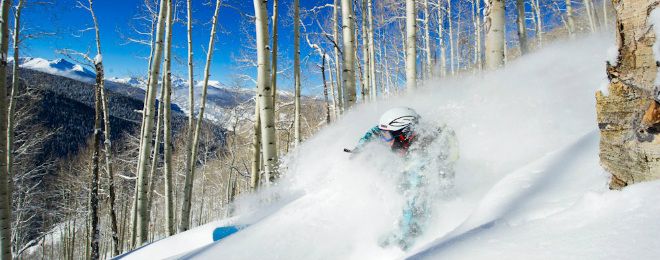
photo credit: Vail Resorts
Freeriders can spend the day at the Golden Peak Superpipe and Terrain Park, which features an award-winning Superpipe and more than 40 rails. Vail’s lift system makes it easy for riders to avoid catwalks and flat areas so they can spend the day accumulating vertical trails instead of going across the mountain. Learn the basics at the Mule Skinner and Bwana parks. Vail hosts top freeskiing and snowboarding events each winter, including the spectator-friendly U.S. Freeskiing Open and Honda Session snowboarding in January-complete with great parties and live music.
Mountain Restaurants at Vail
The 15 restaurants on Vail Mountain include flagship Two Elk Lodge straddling the Front Side and the Back Bowls and exclusive Game Creek, accessible by snowcat or the Eagle Bahn gondola.
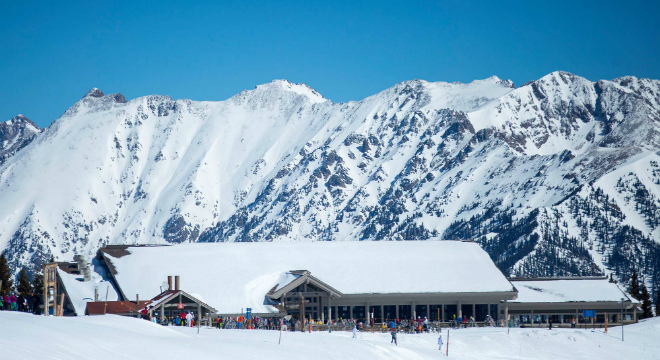
The Two Elk Lodge (photo credit: Vail Resorts)
There are more than 15 restaurants to choose from on Vail Mountain, such as Two Elk Restaurant, Vail Mountain’s flagship restaurant at the top of China Bowl. It’s open for lunch only and has expanded outdoor picnic seating to enjoy Southwestern menu items including wraps, gourmet pizza, pasta and more. Many self-service restaurants are pricey and can be crowded at lunchtimes, and in this respect there is a need for some improvement in mountain restaurant facilities.
If rustic indoor or outdoor barbecueing of smoked chicken, soups and grilled sandwiches are your preference, you’ll want to get to Wildwood Smokehouse at the top of Wildwood Express and Game Creek Express. Sample the spectacular views of the Sawatch Range from here. Mid-Vail Food Courts has a New York-style deli, fajita bar, grill and pasta bar on the Terrace Level. There you’ll also find an American diner, and the Gore Range Grill on the Look Ma level, with spectacular views of the Gore Range. There’s a “Great Lunch for less” option with pasta, salad, and drink for less than $8. Skiers and snowboarders can take advantage of great lunch options at Larkspur, which features chef Thomas Salamunovich’s mix of American and rustic French cuisine at the base of Golden Peak. It’s been listed as a “Don’t Miss while in Vail” in U.S.A. Today.
Undoubtedly Vail’s finest on-mountain restaurant is Game Creek, overlooking Game Creek Bowl at the top of Vail Mountain. Ride the Eagle Bahn Gondola to the top for a snowcat ride to the restaurant. Guests are treated to a multi-course menu of Colorado cuisine by chef David Wiehler. It’s a private club at lunch and open to the public for dinner.
While Blue Sky Basin does not have any cafeteria facilities, there are barbeque grills and many locals enjoy grilling on warm spring days. Give it a shot, but remember, you’ll have to pack in your supplies.
Before you hit the slopes try Blizzard’s Deli for great coffee and breakfast burritos or DJ’s for any breakfast craving, be it omelets or French toast.











